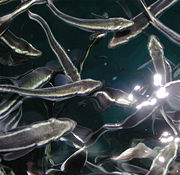|
Cobia
Cobia (Rachycentron canadum) — also known as black kingfish, black salmon, ling, lemonfish, crabeaters, aruan tasek, etc. — are perciform marine fish, the sole representative of their family, the Rachycentridae.
Description
Attaining a maximum length of 2 metres (78 inches) and maximum weight of 68 kilograms (150 pounds), Cobia have elongate fusiform (spindle shaped) bodies and broad, flattened heads. Their eyes are small and their lower jaw projects slightly past the upper jaw. On the jaws, tongue and roof of the mouth are bands of villiform (fibrous) teeth. Their bodies are smooth with small scales, their dark brown coloration grading to white on the belly with two darker brown horizontal bands on the flanks. These may not be prominent except during spawning when Cobia lighten in colour and adopt a more prominently striped pattern. The large pelvic fins are normally carried horizontally (rather than vertically as shown for convenience in the illustration), so that, as seen in the water they may be mistaken for a small shark. When boated, the horizontal pelvic fins enable the Cobia to remain upright so that their vigorous thrashing can make them a hazard. The first dorsal fin is composed of six to nine ,independent, short, stout, and sharp spines. The family name Rachycentridae, from the Greek words rhachis meaning "spine" and kentron meaning "sting," is an allusion to these dorsal spines. Mature cobia have forked, slightly lunate tail fins with most fins being a dark brown. They lack air bladders.


A Cobia at an aquarium, showing the horizontal pelvic fins and broad head.
[ Similar Species
Cobia somewhat resemble and are most closely related to the Remora of the family Echeneidae. However, they lack the dorsal sucker of the Remora, their body is far stouter and their tail is far more developed, and forked instead of rounded. Juvenile Cobia are patterned with conspicuous bands of black and white. Their tails are rounded rather than forked as in the adults.
[Distribution and Habitat
Cobia are pelagic and are normally solitary except for annual spawning aggregations; however they will congregate at reefs, wrecks, harbours, buoys and other structural oases. They may also enter estuaries and mangroves in search of prey.


Cobia fingerlings in aquaculture.
[ Feeding Habits
Cobia feed primarily on Crabs, squid and other fish. Cobia will follow larger animals such as Sharks, Turtles and Manta Rays in hope of scavenging a meal. Cobia are intensely curious fish and show no fear of boats. Their predators are not well documented, but the dolphinfish (Coryphaena hippurus) is known to feed on immature Cobia. Shortfin mako sharks are known to feed on adult Cobia and have been seen by fishermen following Cobia during their annual springtime migration in the northern Gulf of Mexico.
[Life History
Cobia are pelagic spawners; that is, they release many tiny (1.2 mm) buoyant eggs into the water which become part of the plankton. The eggs float freely with the currents until hatching. The larvae are also planktonic, being more or less helpless during their first week until the eyes and mouths develop. Males mature at two years and females at three years. Both sexes lead moderately long lives of 15 years or more. Spawning takes place diurnally from April to September in large offshore congregations. Up to 20 individual spawns may take place in one season, with intervals of about one to two weeks. Cobia are frequently parasitized by nematodes, trematodes, cestodes, copepods and acanthocephalans.
[ Migration patterns
Cobia make seasonal migrations along the coasts in search of water in their preferred temperature range. Wintering in the Gulf of Mexico, they migrate north as far as Maryland in the Summer, passing East Central Florida in March.
[ Fishing Gear and Methods
Cobia are powerful fish popular among sport fishermen, and a prized table fare. Cobia are primarily sought by sight casting small Chartreuse jigs to migrating fish, or to fish following Turtles or Manta rays. They are a bycatch taken by commercial fishermen trolling for King Mackerel, or by live Menhaden slow-trolled near reefs and wrecks.
[Utilization
Cobia are sold commercially, and command a high price for their firm texture and excellent flavor. However, there is no directed fishery owing to their solitary nature. They have been farmed in aquaculture for this reason. The meat is usually sold fresh. They are typically served in the form of grilled or poached fillets. Chefs Jamie Oliver and Mario Batali each cooked several dishes made with cobia in the "Battle Cobia" episode of the Food Network program Iron Chef America, which aired in January 2008. |











